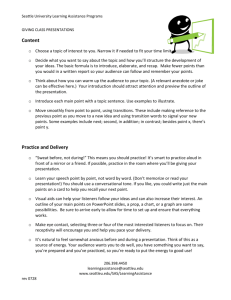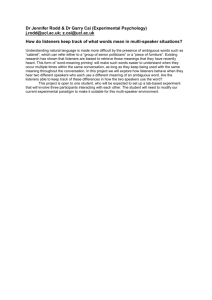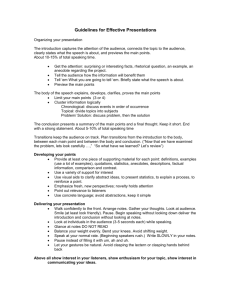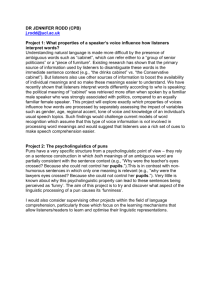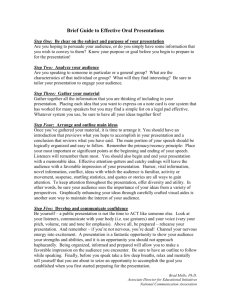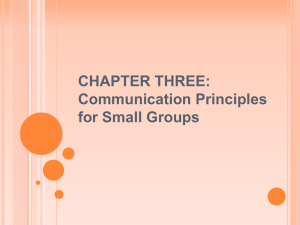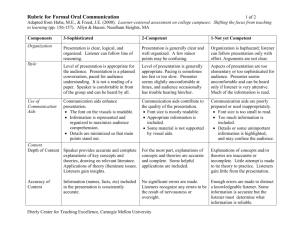ACTFL Guidelines_Listening
advertisement
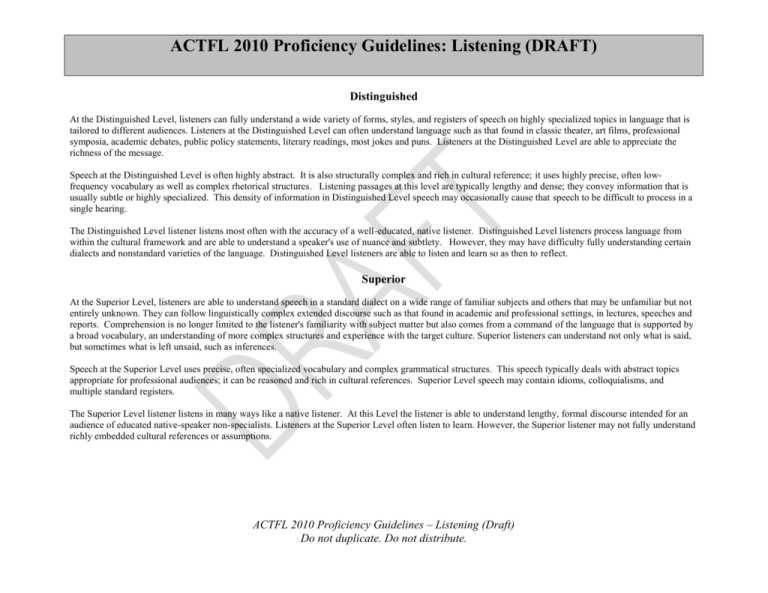
ACTFL 2010 Proficiency Guidelines: Listening (DRAFT) Distinguished At the Distinguished Level, listeners can fully understand a wide variety of forms, styles, and registers of speech on highly specialized topics in language that is tailored to different audiences. Listeners at the Distinguished Level can often understand language such as that found in classic theater, art films, professional symposia, academic debates, public policy statements, literary readings, most jokes and puns. Listeners at the Distinguished Level are able to appreciate the richness of the message. Speech at the Distinguished Level is often highly abstract. It is also structurally complex and rich in cultural reference; it uses highly precise, often lowfrequency vocabulary as well as complex rhetorical structures. Listening passages at this level are typically lengthy and dense; they convey information that is usually subtle or highly specialized. This density of information in Distinguished Level speech may occasionally cause that speech to be difficult to process in a single hearing. The Distinguished Level listener listens most often with the accuracy of a well-educated, native listener. Distinguished Level listeners process language from within the cultural framework and are able to understand a speaker's use of nuance and subtlety. However, they may have difficulty fully understanding certain dialects and nonstandard varieties of the language. Distinguished Level listeners are able to listen and learn so as then to reflect. Superior At the Superior Level, listeners are able to understand speech in a standard dialect on a wide range of familiar subjects and others that may be unfamiliar but not entirely unknown. They can follow linguistically complex extended discourse such as that found in academic and professional settings, in lectures, speeches and reports. Comprehension is no longer limited to the listener's familiarity with subject matter but also comes from a command of the language that is supported by a broad vocabulary, an understanding of more complex structures and experience with the target culture. Superior listeners can understand not only what is said, but sometimes what is left unsaid, such as inferences. Speech at the Superior Level uses precise, often specialized vocabulary and complex grammatical structures. This speech typically deals with abstract topics appropriate for professional audiences; it can be reasoned and rich in cultural references. Superior Level speech may contain idioms, colloquialisms, and multiple standard registers. The Superior Level listener listens in many ways like a native listener. At this Level the listener is able to understand lengthy, formal discourse intended for an audience of educated native-speaker non-specialists. Listeners at the Superior Level often listen to learn. However, the Superior listener may not fully understand richly embedded cultural references or assumptions. ACTFL 2010 Proficiency Guidelines – Listening (Draft) Do not duplicate. Do not distribute. ACTFL 2010 Proficiency Guidelines: Listening (DRAFT) Advanced At the Advanced Level, listeners can understand the main ideas and most supporting details of connected discourse on a variety of familiar topics of general interest such as news stories, explanations of how to do something, anecdotes, or travelogue description. Listeners can use real-world knowledge to complement their growing lexical and structural control of the language. Listeners may also show some understanding of oral texts at higher levels if they possess significant familiarity with the topic or context. Advanced Level listeners show an emerging ability to listen to learn. Advanced Level speech is authentic, connected and ranges from one to several paragraphs in length. This speech is lexically and structurally uncomplicated. The discourse is straightforward and is generally organized in a clear and predictable way. Advanced Level listeners demonstrate a growing ability to process language on an expanding range of topics. They have sufficient knowledge of language structure to understand basic time-frame references. Nevertheless, their understanding is limited to concrete, conventional discourse. Advanced High At the Advanced High Level, listeners are able to understand Advanced Level speech with ease and confidence. They can follow many of the essential points of oral discourse at the Superior Level in areas of special interest or knowledge. These listeners are able to understand substantial segments of an oral text that is conceptually abstract and linguistically complex. In addition they can also understand parts of texts that deal with unfamiliar topics and situations, as well as some speech that includes references to the target language culture. At the Advanced High Level, listeners are able to comprehend the facts presented in oral discourse and are able to begin making appropriate inferences. Nevertheless there are likely to be gaps in comprehension of Superior Level discourse. Advanced Mid At the Advanced Mid Level, listeners are able to understand speech of several paragraphs in length, particularly if presented with a clear underlying structure. The speech is predominantly in familiar target language patterns. Listeners understand the main ideas and many supporting facts. Comprehension derives not only from situational and subject matter knowledge but also from an increasing facility with the language itself. Advanced Mid listeners may be able to understand some segments of Superior Level discourse. Advanced Low At the Advanced Low Level, listeners are able to understand paragraph-length speech that has a clear underlying structure. The oral text is in familiar target language patterns. The listener understands the main ideas and some supporting facts. Comprehension may derive in large part from situational and subject matter knowledge. At the Advanced Low Level listeners show little or no comprehension of Superior Level discourse. ACTFL 2010 Proficiency Guidelines – Listening (Draft) Do not duplicate. Do not distribute. ACTFL 2010 Proficiency Guidelines: Listening (DRAFT) Intermediate At the Intermediate Level, listeners can understand some information conveyed in simple, loosely connected speech on familiar or everyday topics, such as that in highly standardized messages and announcements or simple instructions and directions. Listeners rely heavily on redundancy, contextual clues, restatement and paraphrasing. At this Level listeners are typically still learning to listen in the target language and not yet able to listen to learn. Intermediate speech imparts basic information. Its content can be reordered without loss of meaning. This speech is non-complex and has a clear underlying internal structure. It contains simple, minimally connected discourse with high-frequency grammatical structures and vocabulary. Intermediate Level listeners are most accurate in their comprehension when getting meaning from simple, straightforward texts. They are able to comprehend messages found in highly familiar contexts about the here and now. Intermediate listeners require a controlled listening environment where they hear what they may expect to hear. Most often, they listen to confirm; rarely do they discover through listening. Intermediate High At the Intermediate High Level, listeners are able to understand with ease and confidence simple connected speech in basic personal and social contexts. They can derive substantial meaning from Advanced Level texts. These listeners can understand most of the main ideas of paragraph-level narrations and descriptions. Some gaps in comprehension of Advanced Level texts may occur. Intermediate Mid At the Intermediate Mid Level, listeners are able to understand simple, connected speech in a variety of basic personal and social contexts. Comprehension is most often even across topics even though a few misunderstandings may occur. Intermediate Mid listeners may be able to understand some segments of Advanced Level discourse. Intermediate Low At the Intermediate Low Level, listeners are able to understand some information and derive some meaning from the simplest, most loosely connected texts in basic personal and social contexts. Comprehension is often uneven. Gaps in understanding usually occur. At the Intermediate Low Level listeners show little or no comprehension of Advanced Level discourse. ACTFL 2010 Proficiency Guidelines – Listening (Draft) Do not duplicate. Do not distribute. ACTFL 2010 Proficiency Guidelines: Listening (DRAFT) Novice At the Novice Level, listeners can understand key words, true cognates and formulaic expressions that are highly contextualized and highly predictable such as those found introductions and basic courtesies. Listeners at this Level are just beginning to learn to listen in the target language. Novice speech is loosely organized with limited or no cohesion. It may rely heavily on extralinguistic support to convey meaning. Novice Level listeners are most accurate when they are able to recognize speech that they can anticipate. In this way, these listeners tend to recognize rather than truly comprehend. Their listening is largely dependent on factors other than the message itself. Novice High At the Novice High Level, listeners are able to begin understanding with ease and confidence speech composed of isolated words and phrases. They are able to understand speech dealing with areas of practical need such as highly standardized messages, phrases, or expressions for instructional and directional purposes, if the vocabulary has been learned. The Novice High listener is able to derive meaning, albeit inconsistently, from Intermediate Level speech where there is contextual and/or extralinguistic support. Novice Mid At the Novice Mid Level, listeners can recognize and begin to understand a number of high frequency, highly contextualized words and/or phrases including cognates and borrowed words. Typically they understand little more than one phrase at a time, and repetition may be required. Sometimes, although rarely, Novice Mid listeners may derive meaning from Intermediate Level speech. Novice Low At the Novice Low Level, listeners are able occasionally to recognize isolated words and/or highest frequency phrases when strongly supported by context. These listeners show virtually no comprehension of Intermediate Level discourse. ACTFL 2010 Proficiency Guidelines – Listening (Draft) Do not duplicate. Do not distribute.
